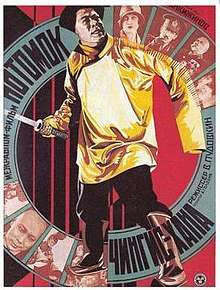Storm over Asia (1928 film)
Storm over Asia (Russian: Потомок Чингисхана, Potomok Chingiskhana, "The Heir to Genghis Khan") is a 1928 Soviet propaganda film directed by Vsevolod Pudovkin, written by Osip Brik and Ivan Novokshonov, and starring Valéry Inkijinoff. It is the final film in Pudovkin's "revolutionary trilogy", alongside Mother (1926) and The End of St. Petersburg (1927).
| Storm over Asia | |
|---|---|
 | |
| Directed by | Vsevolod Pudovkin |
| Written by | O. Brik I. Novokshonov |
| Starring | I. Inkizhinov A. Tchistakov L. Dediseff A. Sudkaveich |
| Cinematography | Anatoli Golovnya |
Release date | 1928 |
Running time | 125 minutes |
| Country | Soviet Union |
| Language | Silent film Russian intertitles |
Plot
In 1918 a young and simple Mongol herdsman and trapper is cheated out of a valuable fox fur by a European capitalist fur trader. Ostracized from the trading post, he escapes to the hills after brawling with the trader who cheated him. In 1920 he becomes a Soviet partisan, and helps the partisans fight for the Soviets against the occupying British army. However he is captured by the British when they try to requisition cattle from the herdsmen at the same time as the commandant meets with a reincarnated Grand Lama. After the trapper is shot, the army discovers an amulet that suggests he is a direct descendant of Genghis Khan. They find him still alive, so the army restores his health and plans to use him as the head of a puppet regime. The trapper is thus thrust into prominence as he is placed in charge of the puppet government. By the end, however, the "puppet" turns against his masters in an outburst of fury.
Historical inaccuracy
It has been pointed out "(1) that the British were never in Mongolia, and (2) that what the cunning British were doing in the film, the cunning Russians were doing in real life."[1]
Unlike such films as October 1917 or Battleship Potemkin, which are about revolutions in European Russia, Storm over Asia concerns itself with a distorted, fictionalised British occupation of Southeastern Siberia and Northern Tibet. The British and the French had supported Russia on a massive scale with war materials during World War I. After the Treaty of Brest-Litovsk, it looked as though much of that material would fall into the hands of the Germans. Under this pretext, Allied intervention in the Russian Civil War began, with the United Kingdom and France sending troops into Russian ports. There were violent confrontations with troops loyal to the Bolsheviks. While film plot was fictional some film footage, such as Cham dance, was filmed during actual ceremony at Tamchinsky datsan.
Cast
- Valéry Inkijinoff — Bair, the Mongol [The Son - U.S.] (as Valeri Inkishanov)
- I. Dedintsev — The British Commandant
- Aleksandr Chistyakov — The Russian Rebel Leader
- Viktor Tsoppi — Henry Hughes, unscrupulous fur-buyer.
- F. Ivanov — The Lama
- V. Pro — British missionary, translates amulet
- Boris Barnet — British soldier, pipe smoker
- Karl Gurniak — British soldier
- I. Inkizhinov — Bair's Father
- L. Belinskaya — The Commandant's Wife
- Anel Sudakevich — Commandant's blonde daughter
Trivia
In the years 2000 - 2003 the Tuvan band Yat-Kha accompanied the film with their own soundtrack on multiple live-events in the USA and europa.[2][3]
External links and References
- Otto Mänchen-Helfen, Journey to Tuva, Los Angeles 1992 (translation of the 1931 German edition), p.208
- http://www.yat-kha.ru/en/biography
- http://powermetal.de/content/artikel/show-YAT-KHA__Interview_mit_Albert_Kuvezin,5609-1.html